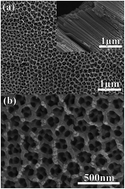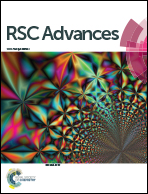Electrochemically self-doped hierarchical TiO2 nanotube arrays for enhanced visible-light photoelectrochemical performance: an experimental and computational study†
Abstract
A two-step electrochemical anodization method was used to prepare typical hierarchical top-ring/bottom-tube TiO2 nanotube arrays (TNTAs). Ti3+ self-doping into TiO2 was achieved via electrochemical reduction at different negative potentials in the range from −1.0 V to −1.6 V. Compared with the pristine TNTAs, the TNTAs reduced at −1.4 V presented a dramatically enhanced photoelectrochemical performance, which showed a 2.4 times enhancement in photocurrent density under simulated AM 1.5G illumination and 2.3 times increase in visible-light photocurrent density. Approximately 100% improvement in photoelectrochemical catalytic efficiency was obtained in a phenol degradation experiment. First-principles calculations demonstrated that the new states induced by Ti3+ self-doping might act as a shallow donor level to promote the separation of photogenerated electron–hole pairs. Moreover, the light absorption improved by the hierarchical nanostructure and the excellent electron conductivity induced by Ti3+ doping also account for the enhancement in the photoelectrochemical performance. These results suggest a reasonable design of photoelectrodes for efficient photoelectrochemical applications in the future.


 Please wait while we load your content...
Please wait while we load your content...